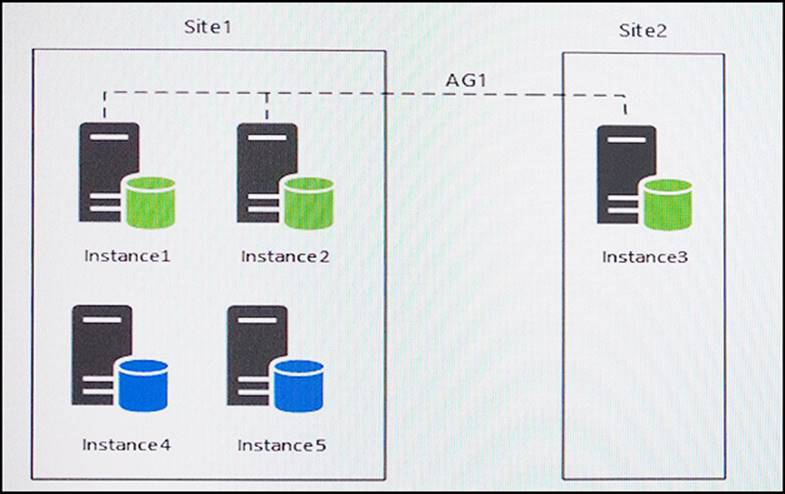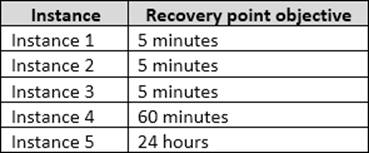Which backup plan should you create?
You have five servers that run Microsoft Windows 2012 R2. Each server hosts a Microsoft SQL Server instance. The topology for the environment is shown in the following diagram.

You have an Always On Availability group named AG1.
The details for AG1 are shown in the following table.

Instance1 experiences heavy read-write traffic. The instance hosts a database named OperationsMain that is four terabytes (TB) in size. The database has multiple data files and filegroups. One of the filegroups is read_only and is half of the total database size.
Instance4 and Instance5 are not part of AG1. Instance4 is engaged in heavy read-write I/O.
Instance5 hosts a database named StagedExternal. A nightly BULK INSERT process loads data into an empty table that has a rowstore clustered index and two nonclustered rowstore indexes.
You must minimize the growth of the StagedExternal database log file during the BULK INSERT operations and perform point-in-time recovery after the BULK INSERT transaction. Changes made must not interrupt the log backup chain.
You plan to add a new instance named Instance6 to a datacenter that is geographically distant from Site1 andSite2. You must minimize latency between the nodes in AG1.
All databases use the full recovery model. All backups are written to the network location \SQLBackup. A separate process copies backups to an offsite location. You should minimize both the time required to restore the databases and the space required to store backups.
The recovery point objective (RPO) for each instance is shown in the following table.

Full backups of OperationsMain take longer than six hours to complete. All SQL Server backups use the keyword COMPRESSION.
You plan to deploy the following solutions to the environment. The solutions will access a database namedDB1 that is part of AG1.
Reporting system: This solution accesses data in DB1with a login that is mapped to a database user that is a member of the db_datareader role. The user has EXECUTE permissions on the database. Queries make no changes to the data. The queries must be load balanced over variable read-only replicas.
Operations system: This solution accesses data inDB1with a login that is mapped to a database user that is a member of the db_datareader and db_datawriter roles. The user has EXECUTE permissions on the database. Queries from the operations system will perform both DDL and DML operations.
The wait statistics monitoring requirements for the instances are described in the following table.

You need to create a backup plan for Instance4.
Which backup plan should you create?
A . Weekly full backups, nightly differential. No transaction log backups are necessary.
B . Weekly full backups, nightly differential backups, transaction log backups every 5 minutes.
C . Weekly full backups, nightly differential backups, transaction log backups every 12 hours.
D . Weekly full backups, nightly differential backups, nightly transaction log backups.
Answer: B
Explanation:
From scenario: Instance4 and Instance5 are not part of AG1. Instance4 is engaged in heavy read-write I/O.
The recovery point objective of Instancse4 is 60 minutes. RecoveryPoint Objectives are commonly describedas the amount of data that was lost during the outage and recovery period.
References: http://sqlmag.com/blog/sql-server-recovery-time-objectives-and-recovery-point-objectives
Latest 70-764 Dumps Valid Version with 451 Q&As
Latest And Valid Q&A | Instant Download | Once Fail, Full Refund

